The New Urban Agenda, being adopted at Habitat III, requires a coherent and legible global urban scientific community to provide expertise to direct and assess progress on urban sustainability transformations. As we have commented in Nature’s special section on Habitat III, the urban research community is currently institutionally marginalized and poorly prepared to interact effectively with global urban science policy platforms. We have five specific recommendations for the urban scientific community to support the global urban agenda and successfully implement this New Urban Agenda, or NUA, after Habitat III.
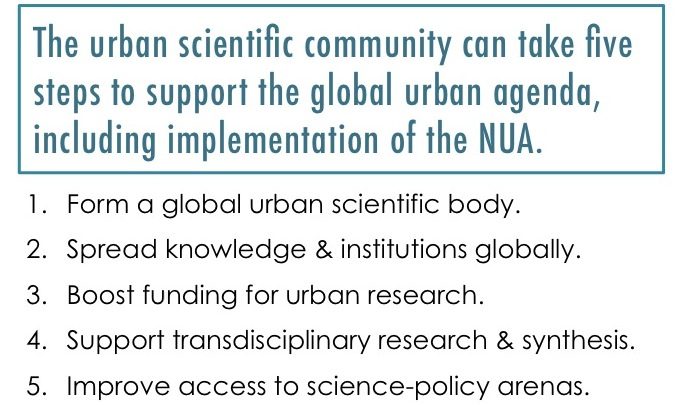
The battle for sustainability will be won or lost in cities (NUA, 2016). Every twenty years, the UN convenes a major cities conference. The third, Habitat III—addressed in various places elsewhere on TNOC—opens in mid-October in Quito, Ecuador, to adopt a global framework for transforming cities toward sustainability—the so-called New Urban Agenda (or NUA). This is significant because it is the first major international convening following the 2015 UNFCCC COP21 Paris Agreement on climate, the Sendai Framework on Disaster Risk Reduction and, critically, the 2030 Agenda for Sustainable Development and the associated Sustainable Development Goals (or SDGs). The success of these multilateral agreements rests on catalyzing complex transformative change across the global system of cities—a tall order for international processes.
Unlike the aforementioned global policy processes, where the views from science were central to making the case for change, the voices of experts in Habitat III have been largely disregarded. One explanation is that, throughout the drafting process, the role of science was organizationally subsumed by that of civil society as part of the Global Alliance of Partners (or GAP). Also, during the penultimate drafting of the NUA in Surabaya in late July, negotiators dropped the proposed Multi-Stakeholder Panel, which would have included scientists, as a formal mechanism for implementing the NUA (NUA 2016). However, the urban research community itself may bear some responsibility for its marginalization in Habitat III. We are often a disparate “community” lacking the level of international coordination of, say, the climate or ecological research communities, which have developed over decades thanks to strong professional networks.
We argue that the case for a powerful and independent urban science policy interaction rests on the dire implications of failing to understand or respond to scientific evidence of the cumulative and accelerating pace of increasingly urban-driven development processes and consequent global environmental change. This change, the Great Urban Acceleration, lies at the heart of the sustainable development opportunity. It is also well understood by the drafters of the NUA, as is a general awareness that this is a critical window of opportunity to make cities pathways for transitions towards sustainable development (Revi & Rosenzweig 2013).
The product of consensual politics, the Habitat III agenda espouses a welcome and important holistic perspective. It is also, however, both hugely ambitious and too vague to be of immediate practical value: the mechanisms for catalyzing rapid transformation in individual cities or city systems are entirely absent (Cohen, 2016). Rapidly shifting urban conditions and the catalytic role of cities in sustainability mean that over the 20-year policy cycle of Habitat III, some review and recalibration will be imperative. Habitat III attendees are actively engaging with the challenges of linking scientific knowledge to participatory solutions via an innovative science-policy interface, but much work will need to follow the conference itself. We argue that if the NUA fails to establish a satisfactory science policy interface through the Habitat III process, an alternative means must be found for ensuring urban goals are informed by scientific knowledge.
The Great Urban Acceleration: global sustainability hinges on urban sustainability
Urban development pathways will continue to dominate global change (Grimm et al., 2008). In the next 30 years, there will be more urban areas built—largely in Africa and Asia—than in the whole of history combined, driving demand for urban infrastructure, roads, pipes and mobile technology, food, energy, water, and housing, and shifting the burden of disease (UN 2014). Urban sprawl, the least sustainable of all growth strategies, is evident across all the major regions of the world (Seto et al. 2011). Settlement expansion puts tremendous pressure on immediate and displaced biophysical environments to sustainably supply services critical to urban livelihoods (Elmqvist et al. 2013).
Cities are significant sites of resource depletion and climate-induced risk. For example, recent flood disasters in the United States (2005, 2008, 2012), the Philippines (2012, 2013), and Britain (2014) have demonstrated increasing vulnerability of coastal and riparian cities to storm surge flooding, with US$ trillions of assets at stake (Aerts et al. 2014). At the same time, simply meeting the demand for urbanization will exhaust any reasonable chance of success of staying within the 2015 Paris Agreement’s carbon budget.
Many of these upward trends are accelerating, including climate change in cities, infrastructural investment, land use and land cover change, inequality in health and income, and urban population expansion (Figure 1). While any one of these challenges alone requires ambitious action that must begin immediately to reduce risk, as well as to improve urban livelihoods and environmental sustainability, the challenges also intersect and influence each other, requiring a more complex urban system approach to cities to elucidate scientifically validated pathways for more desirable urban futures. Yet, cities are often engines of innovation (Glasser 2011); to date, the most progress is being made on climate change (Revi et al. 2014, Seto et al., 2014, Rosenzweig et al. 2010) and other sustainability goals (UNEP 2016, Kanuri et al. 2016) in cities.
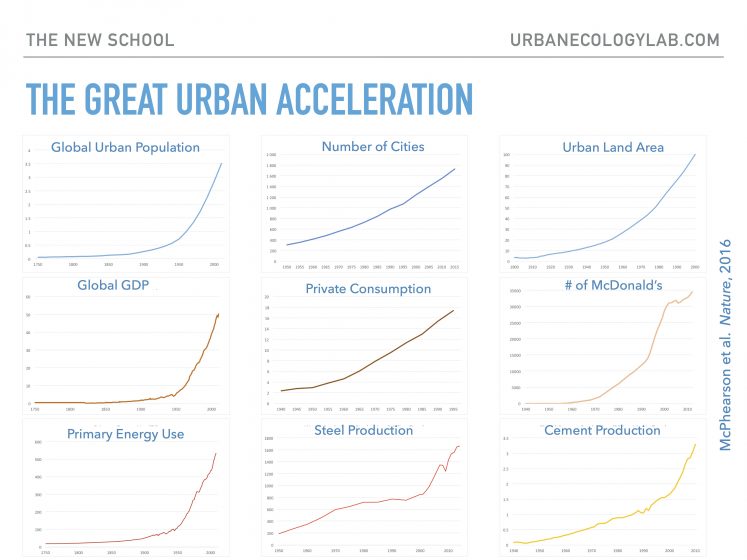
Rapid urbanization represents one of the biggest social transformations in human history (e.g., Bai et al. 2014). Cities display emergent properties, have dynamics that are nonlinear and often far from equilibrium, have a rapacious appetite for energy (Batty 2008), and are thus difficult to plan, manage, and govern. Drawing on the evidence from diverse conditions around the world, the essentially urban characteristics of sustainability are, however, increasingly understood (OECD, 2016; Simon 2016). Developing an urban science with methods and tools that, while sensitive to context, can address the social, ecological, and technical infrastructural complexity of urban systems is key to advancing the goals of improving urban sustainability, livability, social equity, and resilience, especially at the global scale (McPhearson et al. 2016).
The New Urban Agenda
The NUA negotiations reveal the difficulty of the UN in accommodating inputs from non-state actors, including the research community. The Habitat III preparatory process drew on a system of expert panels and a General Assembly of Partners, and early drafts of the NUA made provision for a Multi-Stakeholder Panel (or MSP) for ongoing extra-state engagement with UN structures. It seems that the MSP, the only possible placeholder for a more formal science-policy engagement in the NUA, was cut because European Union members and other high-income countries were concerned at the cost of funding such a broad mechanism, while there were wider concerns about the precise mandate of the MSP in monitoring and evaluation. Science was not the only casualty of the excision of the MSP in Surabaya and the latest drafts of the NUA still lack clarity on how local governments—absolutely critical stakeholders in the sustainability transition—will engage the global urban agenda.
Meaningful implementation, monitoring, evaluation, and revision of the NUA and related SDGs will require coordinated and sustained research evidence from the scientific community (including natural scientists, social scientists, humanities scholars, practitioner scholars, and professionals). Implementation also requires the urban scientific community be organized, representative, and seen as legitimate if it is to provide necessary input to any emergent science-policy platform.
The development of a coherent global urban scientific community is therefore one of the most critical, and currently missing, components of achieving the NUA. Habitat III must demand that the urban scientific community organize itself to meet the needs of the NUA and ensure its integration into the wider global urban agenda.
Lack of a coherent urban science
Despite having played a critical role in articulating the need for a global urban policy agenda in the SDGs and the development of the NUA, the urban scientific community is not coherent, organized, or legible (Parnell, Crankshaw and Acuto 2016). This lack of coherence makes it currently impossible for there to be inclusive scientific input into any global science-policy platform for achieving the goals of the NUA and related SDGs. This lack of disciplinary and methodological coherence is compounded by the context-specific nature of urban research and solutions. For example, African urbanization trajectories can be very different from those in Asia or in the Americas (Bloom et al. 2008). Most urban scientific research and academic institutions are located in the Global North and/or large cities, while some of the most pressing urban challenges are in the Global South and in small- to medium-sized cities. Additionally, cities are a growing locus for scientific research and have enormous influence on one another, especially at regional (but also global) scales. Beyond Europe, where the regional urban system is fairly well understood, scientists have so far mostly failed to address cities at the regional scale.
Given the geographical diversity of cities and the complexity of issues encompassed by the urban question, it is unsurprising that there has been a proliferation of scholarly communities engaging in sustainable urban development. Taken as a whole, urban science is mostly not inter- or trans-disciplinary in theory, method, or data, and existing resources are not aligned with areas of the greatest need.
In brief, the research community, located both within and outside of academia, is heterogeneous and unevenly distributed worldwide in terms of depth, resourcing, and especially in interdisciplinary and trans-disciplinary experience. The skills of drawing together and synthesizing the multiple sources of urban knowledge that must inform global urban policy are in short supply, but are essential in view of the complexity of urban processes and phenomena. Paradoxically, experience in working with complexity is commensurately greater in countries of the Global South than in the North, where academic institutional practices and research evaluation processes frequently reinforce disciplinary barriers on the ground, and foster narrow specialization that is antithetical to addressing complex urban problems across sectors and scales.
A new urban science
Achieving the SDGs and the NUA requires that the global urban scientific community come together to develop a new urban science, including new institutions, new funding mechanisms, and new research agendas to support fresh knowledge generation on the urban transition. Scientists must expand primary research in little studied and rapidly changing urban contexts, as well as developing a new urban systems science aligning and responding to emerging, evidence-based policy needs. Setting aside the self-evident imperative of the need for a fundamental expansion of Southern urban research capacity and funding, which will take time and considerable resources to resolve, reforms for building an inclusive global urban scientific community and developing a new urban science could be achieved more rapidly and would have immediate and positive impact for policymakers. Several approaches for attaining these aims have been considered.
One model advocated during NUA negotiations is an urban equivalent of the Intergovernmental Panel on Climate Change (or IPCC), designed to lend independence and authority by weighing the accumulated evidence in recent scientific and grey literatures. However, the intergovernmental nature of the IPCC has proved burdensome in recent years, with cumbersome processes and arrangements, increased difficulty in ensuring integration between the Working Groups, and escalating workloads and travel for Working Group members.
The sustainable urban development agenda is broad and, while focused on the NUA, also cuts across the entire UN system. Urban scientists don’t necessarily agree on the most important research questions, which limits the possibilities of an IPCC-like body to advise global and local policymaking. For example, the IPCC began with clear aims to establish the magnitude and impact of climate change, and to understand the drivers and the response strategies. Urban system challenges require a much more complex and interrelated set of questions about equity, justice, climate resiliency, economic opportunity, infrastructure development, ecological restoration, and more.
One strength of the IPCC is that it has helped focus a strong, internationally coordinated research community. IPCC findings, however, require clearance by member governments—an assessment of cities may require an even more torturous, sub-national clearance level, and may generate political tensions from opposition-run Councils. Crucially, too, the IPCC does not undertake new research, but rather collates and assesses the existing literature. Given the paucity of published scholarship on the cities of the Global South, adoption of the IPCC process might inadvertently reinforce current distortions and further encourage inappropriate interventions. We believe, moreover, that an IPCC-like model will probably move too slowly to address the urgency of urban social and environmental challenges, and would limit the need for fundamentally new urban system research.
The NUA and related SDGs require new research that is more credible both thematically and geographically. The researchers, therefore, will need to be on the ground in different locales for differing durations, often working collaboratively and integratively with local, regional, and national governments (Simon et al. 2016), and coordinating with the practitioner scholars within these levels of government to maximize the benefits of their research—none of which lends itself to an IPCC-like mechanism.
Beyond city limits
We propose 5 key steps for science to support the global urban agenda, including implementation of the NUA:
1. Build global urban science. The urgency of urban growth issues demands the building of a new urban science and a rapid change in research and institutional organization. As a starting point, we recommend that a global urban scientific body be formed to address issues of science pertaining to the urban question in the post 2030 agenda. This could take the form of an urban scientific network of networks based on (or amalgamate of) existing global networks with a strong science policy commitment. These existing networks include urban clusters with the IPCC, IPBES, UN-Habitat, the United Nations Environment Programme, the Future Earth Cities Knowledge Action Network (KAN), and the Sustainable Development Solutions Network. The final form of a new, coordinated, and legible global urban scientific community should be developed in consultation with scientists, professional societies, and urban knowledge holders at all levels. This will take time but can start with scientific leaders within existing institutions as a pragmatic initial step. Governance of this body should be planned inclusively and could be based on the polycentric model developed within Future Earth, allowing distributed regional hubs with ability to be responsive to different research needs locally and regionally.
2. Map knowledge and institutions globally. Inclusivity and diversity across geographic regions and scientific domains is key to legitimacy and legibility. Most research is in the North, yet most need is in the South. We need major investment in academic institutes at the nexus of urban research-policy-practice in rapidly urbanizing cities. Mapping knowledge and institutions would help to uncover key geographic and thematic gaps in knowledge and scientific research capacity.
3. Boost urban research and funding mechanisms. Truly global sources of research funding are needed to allow cross-comparison studies of cities and regions. These sources should be set up with support from national governments, development banks and private foundations. This would require significantly large sums, which is one of the reasons the MSP was taken out of the final NUA draft. Still, scientific funding issues must be addressed if we are to make real progress on the global urban agenda.
4. Support trans-disciplinary research synthesis. It is crucial that scientists and other communities of practice with relevant knowledge have a significant seat at the table to generate policy to guide urban development over the short- and long-terms. Transdisciplinary research must be not only supported through new urban science funding and organization, but also be a centerpiece of synthesizing existing knowledge and new knowledge generation for input to policymaking at global, regional, and local levels.
5. Improve access to science policy arenas. Urban scientists must have a clear role within emerging science-policy platforms in the New Urban Agenda and the wider multilateral system, such as the links forming between the urban SDGs and the Future Earth Cities KAN. As a start, the role of independent urban experts including multiple types of knowledge holders across multiple disciplines must be made clear within the New Urban Agenda and its implementation stage through development of a strong, diverse, and inclusive science-policy interface to achieve the NUA and related SDGs.
We must deal seriously with the complexity of urban systems and overcome institutional reticence to understand the emergent behavior and properties of urban systems as they evolve and change. The imperative of scaling up urban research and fostering a global scientific research leadership that is able to direct and critique global urban policymaking and implementation cannot be underestimated.
Timon McPhearson, Susan Parnell, David Simon, Owen Gaffney, Thomas Elmqvist, Xuemei BAI, Aromar Revi, Debra Roberts
New York City, Cape Town, Gothenburg, Stockholm, Stockholm, Canberra, Bangalore, and Durban
This post produced with contributions from Laura Booth.
A version of this essay originally appeared in Nature Commentaries.
To read more on this subject, see coverage of this topic and the Nature commentary at The Guardian and NYU’s Center for Urban Science + Progress.
References
Aerts JCJH, Botzen WJW, Emanuel K, Lin N, de Moel H, Michel-Kerjan EO. 2013. Evaluating Flood Resilience Strategies for Coastal Megacities. Science 344: 473-475.
Bai, X., P. Shi, Y. Liu. 2014. Realizing China’s urban dream. Nature, 509: 158-160.
Batty M. 2008. The size, scale, and shape of cities. Science 319: 769–771.
Dobbs, Richard, Jaana Remes, James Manyika, Charles Roxburgh, Sven Smit, and Fabian Schaer. Urban world: Cities and the rise of the consuming class. McKinsey Global Institute, 2012.
Elmqvist T, Fragkias M, Goodness J, Güneralp B, Marcotullio PJ, McDonald RI, Parnell S, Schewenius M, Sendstad M, Seto KC, Wilkinson C, eds. 2013. Urbanization, Biodiversity and Ecosystem Services: Challenges and Opportunities. A Global Assessment. Springer. doi:10.1007/978-94-007-7088-1_1.
Glaeser, E. 2011. Cites: Engines of Innovation. Scientific American
Graute, U. 2016. Local authorities acting globally for sustainable development. Regional Studies http://dx.doi.org/10.1080/00343404.2016.1161740.
Grimm, N.B., et al., 2008. Global change and the ecology of cities. Science, 319(5864), pp.756-760.
Güneralp, Burak. “Resource Use For The Construction And Operation Of Built Environments.” Eds. Karen C. Seto, William D. Solecki and Corrie A. Griffith. The Routledge Handbook of Urbanization and Global Environmental Change (Routledge International Handbooks) Taylor and Francis. Kindle Edition.
International Energy Agency (IEA), 2008. World Energy Outlook 2008. Paris.
Kanuri, C, Revi, A, Espey, J, and Kuhle, H. 2016 Getting started with the SDGs in Cities, SDSN Available at: https://sdgcities.guide/
McPhearson, T, Pickett STA, Grimm N, Niemelä N, Alberti M, Elmqvist T, Weber C, Haase D, Breuste J, and Qureshi S. 2016. “Advancing Urban Ecology Toward a Science of Cities.” BioScience 66(3):198-212, doi: 10.1093/biosci/biw002.
New Urban Agenda (NUA) 2016. HABITAT III, Draft New Urban Agenda, Post-Surabaya Draft, 28 July 2016. Available at: http://citiscope.org/sites/default/files/h3/Surabaya_Draft_New_Urban_Agenda-28_July_2016.pdf
Nillsen M, Griggs D, Visbeck M. 2016. Map the interactions between Sustainable Development Goals. Nature. 534: 320-322.
Parnell, S. Crankshaw, O, Acuto, M (2016) http://www.urbantransformations.ox.ac.uk/news-debate/key-debates/
Parnell, S. 2016: Defining a global urban development agenda, World Development, 78, 529–54
Revi A, Satterthwaite DE, Aragón-Durand F, Corfee-Morlot J, Kiunsi BR, Pelling , Roberts DC, and Solecki W. 2014. Chapter 8 “Urban areas.” In: Climate Change 2014: Impacts, Adaptation and Vulnerability. IPCC Working Group II Contribution to AR5. Cambridge University Press: 535-612
Revi A, Rosenzweig C 2013 The urban opportunity: Enabling transformative and sustainable development. UN High Level Panel
Rosenzweig C, Solecki W, Hammer SA, Mehrotra S. 2010. Cities lead the way in climate-change action. Nature 467: 909–911.
Seto, K.C., Güneralp, B. and Hutyra, L.R., 2012. Global forecasts of urban expansion to 2030 and direct impacts on biodiversity and carbon pools. Proceedings of the National Academy of Sciences, 109(40). 16083-16088. DOI: 10.1073/pnas.1211658109.
Seto KC, Dhakal S., Bigio, A., Blanco, H., Delgado, G.C., Dewar, D., Huang, L., Inaba, A.,Kansal, A., Lwasa, S., McMahon, J., Müller, D.B., Murakami, J., Nagendra, H. and Ramaswami, A. (2014) Chapter 12 – Human settlements, infrastructure and spatial planning. In: Climate Change 2014: Mitigation of Climate Change. IPCC Working Group III Contribution to AR5. Cambridge University Press.
Shao, M., Tang, X., Zhang, Y. and Li, W. (2006), City clusters in China: air and surface water pollution. Frontiers in Ecology and the Environment, 4: 353–361. doi:10.1890/1540-9295(2006)004[0353:CCICAA]2.0.CO;2
Simon, D (ed.) 2016. Rethinking sustainable cities: Accessible, green and fair. Bristol: Policy Press. Available at https://oapen.org/search?identifier=613676.
Simon D, Arfvidsson H, Anand G, Bazaaz A, Fenna G, Foster K, Jain G, Hansson S, Marix Evans L, Moodley N, Nyambuga C, Oloko M, Chandi Ombara D, Patel Z, Perry B, Primo N, Revi A, Van Niekerk B, Wharton A and Wright C. 2016. Developing and testing the Urban Sustainable Development Goal’s targets and indicators – a five-city study, Environment and Urbanization 28(1), 49-63. http://dx.doi.org/10.1177/0956247815619865.
[UN] United Nations, Department of Economic and Social Affairs, Population Division. 2014. World Urbanization Prospects: The 2014 Revision Highlights. UN.UNEP Global Initiative for Resource Efficient Cities. http://www.unep.org/pdf/GI-REC_4pager.pdf
Wang, Tao, Daniel B. Müller, and T. E. Graedel. “Forging the anthropogenic iron cycle.” Environmental science & technology 41, no. 14 (2007): 5120-5129.
about the writer
Sue Parnell
Professor Sue Parnell is an urban geographer in the Department of Environmental and Geographical Sciences at the University of Cape Town and is a founding member of the African Centre for Cities there.
about the writer
David Simon
David Simon is Professor of Development Geography at Royal Holloway, University of London and until December 2019 was also Director of Mistra Urban Futures, an international research centre on sustainable cities based at Chalmers University of Technology, Gothenburg, Sweden.
about the writer
Owen Gaffney
Science writer and journalist Owen Gaffney is a communications consultant for Future Earth and director of international media and strategy at the Stockholm Resilience Centre.
about the writer
Thomas Elmqvist
Thomas Elmqvist is a professor in Natural Resource Management at Stockholm University and Theme Leader at the Stockholm Resilience Center. His research is on ecosystem services, land use change, natural disturbances and components of resilience including the role of social institutions.
about the writer
Xuemei Bai
Professor Bai is a professor in Urban Environment and Human Ecology at Australian National University.
about the writer
Aromar Revi
Aromar Revi is Director of the Indian Institute for Human Settlements. He is an international practitioner, consultant, researcher, and educator with 30 years of interdisciplinary experience in public policy & governance, political economy of reform, development, technology, sustainability, and human settlements.
about the writer
Debra Roberts
Debra Roberts founded and heads the Environmental Planning and Climate Protection Department of eThekwini Municipality, Durban, South Africa.


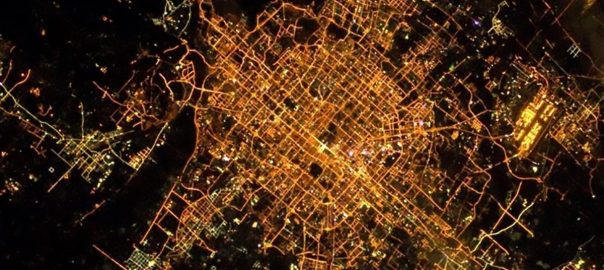
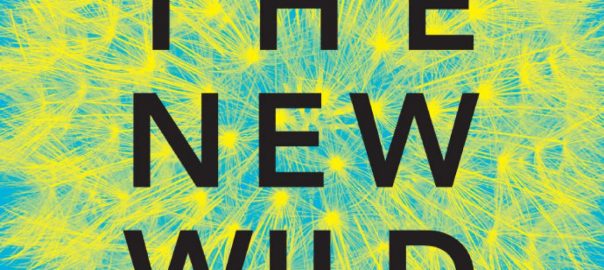
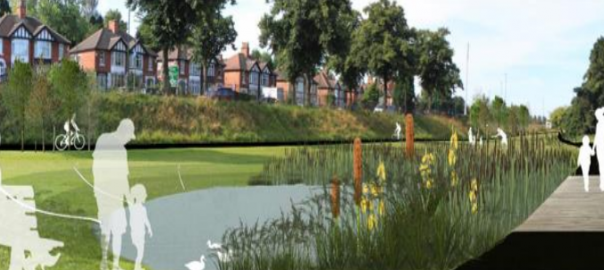
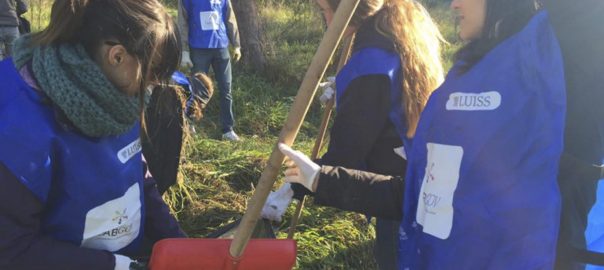
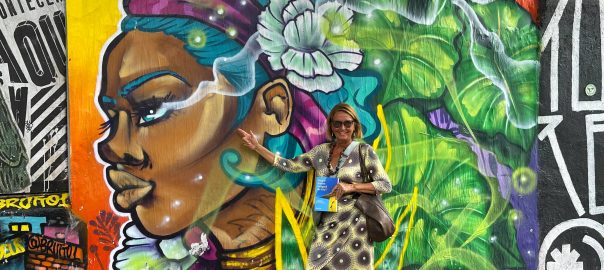
Leave a Reply